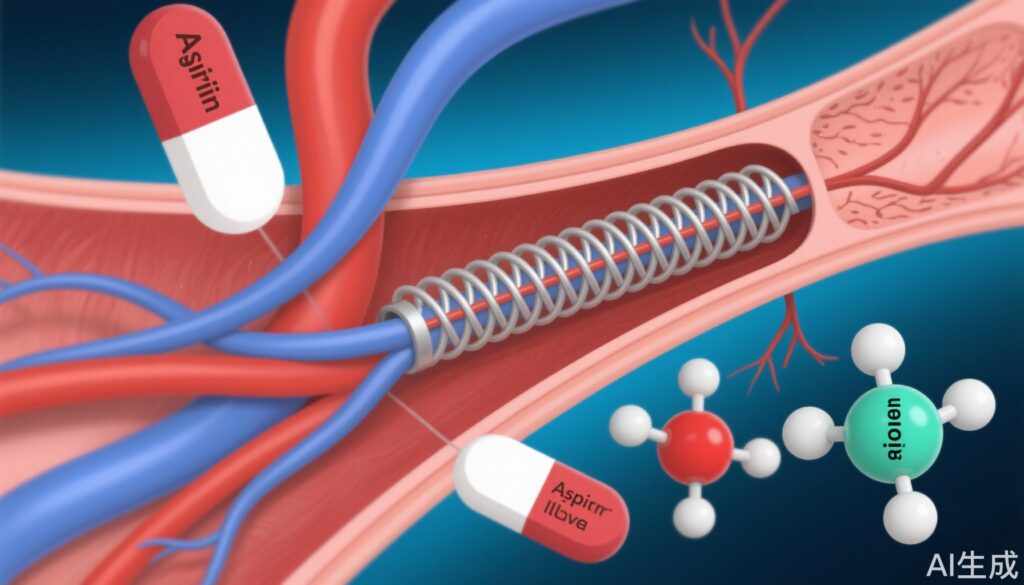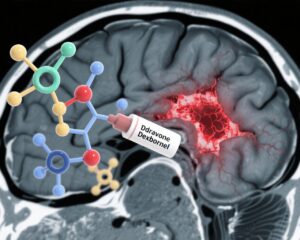Background
Post-thrombotic syndrome (PTS) is a chronic condition characterized by venous hypertension and associated symptoms following deep vein thrombosis. Patients with moderate to severe PTS often undergo endovascular stent placement in stenotic or occluded iliofemoral veins or the inferior vena cava, aiming to restore venous patency and improve quality of life. However, early stent thrombosis, particularly within the first 6 months after intervention, remains a major clinical concern affecting long-term outcomes.
Anticoagulation therapy is standard to prevent thrombosis post-stent implantation. Rivaroxaban, a direct oral anticoagulant (DOAC), has proven effective in treating venous thromboembolism. Aspirin, a platelet aggregation inhibitor, has been commonly combined with anticoagulants in arterial stenting but its benefit in venous stenting is unclear. The ARIVA trial was designed to evaluate whether the addition of aspirin to rivaroxaban improves stent patency and reduces thrombosis compared to rivaroxaban alone in patients with PTS.
Study Design
The ARIVA trial was a multicenter, multinational, randomized, open-label, independently adjudicated clinical study. Eligible participants were adults aged 18 to 75 years with clinically significant PTS (Villalta score >4) and successful recanalization and stent placement in the inferior vena cava, iliac veins, or common femoral vein. Patients with contraindications to anticoagulation or recent (<3 months) acute venous thrombosis were excluded.
Participants were randomized 1:1 to receive 100 mg daily aspirin plus 20 mg daily rivaroxaban or 20 mg rivaroxaban alone for 6 months post-procedure. The primary composite efficacy endpoint was the absence of occlusion in the treated venous segment as determined by serial duplex ultrasound or the absence of reintervention to maintain patency within 6 months. Secondary endpoints included changes in Villalta score assessing PTS severity, quality of life measures, and safety outcomes focusing on bleeding events.
Key Findings
Between 2020 and 2022, 172 patients were screened, 169 randomized, and 162 included in the full analysis set (80 in the aspirin plus rivaroxaban group, 82 in rivaroxaban alone). The average age was 42.8 years, with a predominance of females (60.9%) and primarily White ethnicity (97.5%). Leg ulcers were documented in 7%.
At 6 months, the primary patency rate was 94.8% in the aspirin plus rivaroxaban group versus 92.4% in the rivaroxaban alone group, with an absolute risk difference of 2.4% (95% CI: -13.6 to 18.0), indicating no statistically significant superiority of combination therapy. Both groups showed similar substantial improvement in Villalta scores (mean decrease ~6.7 to 7 points) and comparable quality of life.
Safety profiles were favorable; no major bleeding events occurred in either group. Minor bleeding and adverse events did not differ significantly.
Expert Commentary
The ARIVA trial addresses an important clinical dilemma regarding optimal antithrombotic strategies following venous stenting in PTS patients. Despite biological plausibility advocating aspirin’s antiplatelet effect as an additive benefit to rivaroxaban, the trial’s robust design and multinational scale revealed no additional efficacy of combination therapy over rivaroxaban alone. The exceedingly high primary patency rates in both arms suggest that rivaroxaban alone provides effective thrombosis prophylaxis in this setting.
Limitations include the open-label design which may introduce bias in subjective secondary outcomes, and the relatively young average age limiting generalizability to older populations with higher bleeding risk. The trial also did not evaluate longer-term outcomes beyond 6 months or different aspirin doses.
These findings align with growing evidence favoring DOAC monotherapy for venous thromboembolism-related interventions and caution against unnecessary polypharmacy that may increase bleeding risk without clear benefit.
Conclusion
The ARIVA trial demonstrates that in patients with post-thrombotic syndrome undergoing venous stent placement, a regimen of rivaroxaban alone is as effective and safe as combined aspirin plus rivaroxaban therapy in preventing early stent thrombosis. Clinicians should consider rivaroxaban monotherapy as a simplified strategy that does not compromise vascular patency or clinical outcomes while minimizing bleeding risks. Further studies with longer follow-up and diverse populations are warranted to refine anticoagulation approaches in venous stenting.
References
Barco S, Jalaie H, Sebastian T, Wolf S, Fumagalli RM, Lichtenberg M, Zeller T, Erbel C, Schlager O, Kucher N. Aspirin Plus Rivaroxaban Versus Rivaroxaban Alone for the Prevention of Venous Stent Thrombosis Among Patients With Post-Thrombotic Syndrome: The Multicenter, Multinational, Randomized, Open-Label ARIVA Trial. Circulation. 2025 Mar 25;151(12):835-846. doi: 10.1161/CIRCULATIONAHA.124.073050. Epub 2025 Jan 28. PMID: 39874026; PMCID: PMC11932446.



